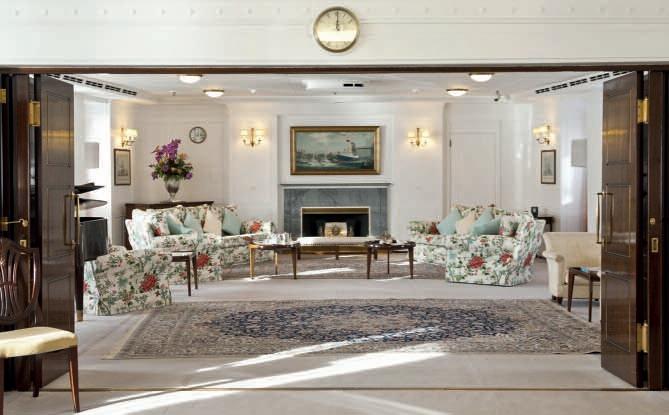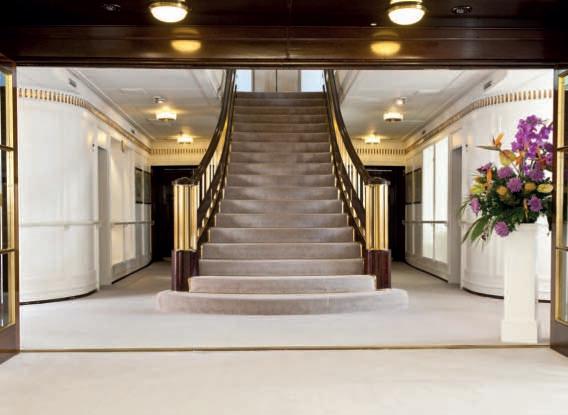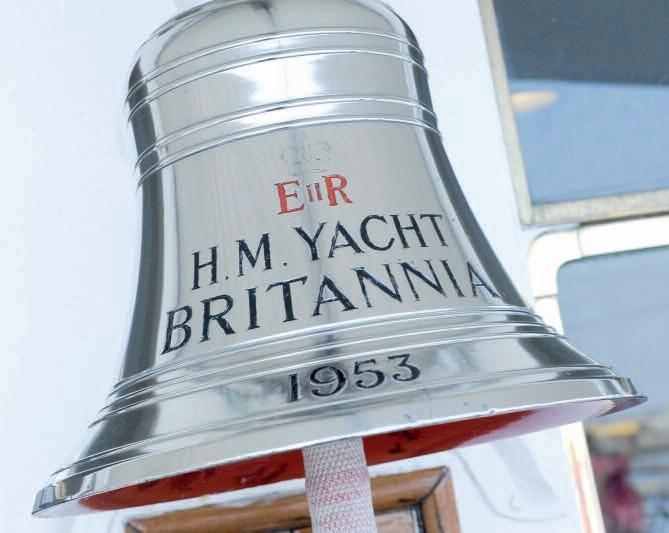
5 minute read
The Royal Yacht Britannia


Advertisement
The Royal Yacht Britannia was home to Her Majesty The Queen and the Royal Family for over 40 years, sailing over 1,000,000 miles around the world. Now berthed in Edinburgh, you can follow in the footsteps of royalty and world leaders such as Sir Winston Churchill and Nelson Mandela to discover the heart and soul of this most special of royal residences.
Britannia is now a five-star visitor attraction and was named the Number 1 UK Attraction in 2014 and has consistently been judged Scotland’s best visitor attraction by VisitScotland for ten years’ running.
You’ll receive a truly warm welcome at Britannia’s visitor centre in Ocean Terminal, which has free parking. Before you step aboard, view the LEGO replica model of Britannia, learn about the history of royal yachts, and see displays and historical photographs of Britannia’s fascinating past. The complimentary audio handset tour covers Britannia’s five main decks. You start at the bridge, explore the state apartments, crew’s quarters and finish at the engine room. From here you can also visit the Royal Sailing Exhibition and learn about the royal racing yacht Bloodhound.
The majority of items on view are the originals, kindly on loan from The Royal Collection and other contributors.
The tour is fully accessible for wheelchair users with lifts and ramps throughout. Britannia is classed as Category 1, the highest level for wheelchair access without assistance, by VisitScotland. In order to enjoy the whole tour, wheelchairs should be no wider than 670mm. The tour is not suitable for Shopmobility electric wheelchair users, and the Royal Deck Tea Room is not accessible by electric wheelchair because the original onboard lift is not big enough.
Britannia is open every day, except Christmas Day and New Year's Day.
Facts
Britannia was launched from the John Brown & Company shipyard in Clydebank on 16 April 1953 by HM The Queen.
During 44 years in royal service Britannia sailed the equivalent of once round the world for each year, calling at over 600 ports in 135 countries.


Unlike any other ship, Britannia was captained by nine Admirals and latterly a Commodore. The full crew consisted of 220 yachtsmen, 20 officers, 3 season officers and, on royal tours, a Royal Marines band of 26 men.
She was built for the dual role of becoming a hospital ship if needed in times of war, but never served this purpose.
Britannia proudly displays her crest on her bow and stern but, unlike other vessels, her name is not on the side of the ship.
Four royal honeymoons took place on board, including Prince Charles and Princess Diana’s in 1986.
When Britannia was decommissioned in 1997, it marked the end of a long tradition of British royal yachts, dating back to 1660 and the reign of Charles II. In total, the British Monarchy has had 83 royal yachts.
2016 marks the 18th anniversary of Britannia’s life as a visitor attraction.
ADMISSION PRICES:
This regular column is where your legal questions will be answered by our resident Legal Eagle. Please be aware that it is not possible to answer your queries directly. If you want a personal reply please use the SIS advice line. Please raise any legal queries you have either by e-mail to info@sisonline.org, tel 0800 0132 305 or fax to 0141 427 9258.
Q.I have noticed a lot of reporting in the press around an employer’s right to access an employees private messages. Can an employer access messages without consent?
A.This controversial issue has been considered recently by the European Court of Human Rights (ECHR). The circumstances concerned an employee based in Romania but is a decision that will affect those in the United Kingdom.
The case concerned an employee who was provided with the use of a Yahoo Messenger account for business reasons. The employer’s policy was that the use of the company IT systems was strictly for business use and that no personal communications were acceptable. The employer suspected that the employee was using the system to send private messages. The employee denied this. The account was accessed and a transcript of the messages was created. This included personal messages to a family member and to his fiancée. Following a disciplinary process, the employee was dismissed for the unauthorised use of the system.
A legal claim challenging the dismissal in Romania was unsuccessful. An appeal to the ECHR followed on the basis that the employee was entitled (under Article 8 of the European Convention on Human Rights) to the right to private life and in relation to correspondence.
The ECHR found that there was no breach of the employee’s rights. This was because the employer accessed the system believing that the messages were all work related after the employee had denied that there were any private messages. Also, the employers use of the transcripts of the messages were only to determine if a disciplinary offence had taken place and not for any other purpose.
The decision is important because it adds clarity to whether or not an employee has the right to privacy in relation to private messages sent at work. An employee does not have a complete right to refuse employer access to private messages but an employer must take great care not to breach the right to privacy by having a legitimate reason for accessing personal communication. The specifics of each scenario will likely need to be examined closely to decide whether an employee has the right to privacy or if the employer is justified in accessing this information.
Q.I have been unable to work since my injury in 2013. Last week my husband told me our marriage is over. He has a well-paid job and I depend on him to pay for everything. I am worried sick about how I will manage in the future.
A.
The end of a marriage is always stressful. This will be particularly acute for you where you feel so financially vulnerable in circumstances where you cannot support yourself.
Your husband has an obligation to maintain you while you remain married. He has a duty to provide aliment, which might take the form of a monthly allowance. Or you could agree he will keep meeting all the household bills and provide you with an amount on top of that to cover other monthly outgoings. It can be a good idea for you both to draw up a schedule of income and outgoings.
Sometimes a court will have to decide what represents a reasonable amount for him to pay in the circumstances, but usually people can agree, with the help of a solicitor who knows about family law, what is fair in your situation.
You should also look into what benefits might be available now you are separated.
On divorce, the obligation to maintain a spouse will sometimes end completely, or will expire after 3 years. But you might come into the exceptional category of cases where a court could order long term financial support to be paid.
First of all, there has to be a division of the matrimonial property. This would include things like the equity in the house and pensions accrued during marriage. While assets are usually split on an equal basis, your inability to work might allow an argument to be made for you to receive more than a 50% share.
Even if you get more than half the assets, if the divorce is going to cause you hardship, a court could also decide your husband should provide you with ongoing maintenance (known as periodical allowance) for a longer period of time.








